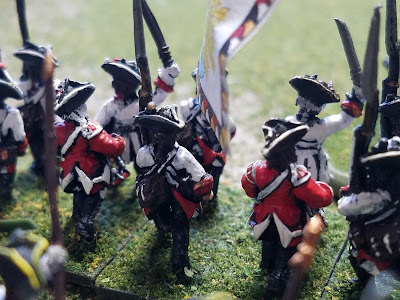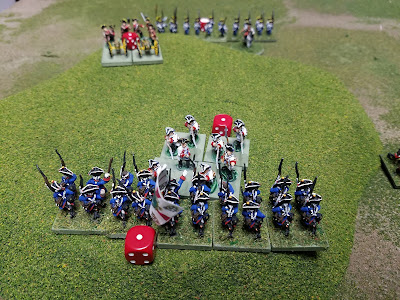While I really enjoyed BattleCry when I played it, it seemed a little too "high octane" for me when assigned only 9-10 units to play an entire battle. We were blowing through the entire battle of Antietam in an hour. I wondered how a game would go with more units? Or perhaps historical units scaled down at the Regimental level?
Enter Scott Mingus' "Enduring Valor" Gettysburg scenario books, written for combat at Regimental level, where the player is maneuvering Regiments around using the Johnny Reb III rules. You might recall I did a series of blog posts where I created a scenario for Norm's outstanding "Two Flags-One Nation" hex-based rules which are also at Regimental scale. I then fought that exciting battle using Norm's rules with historical results.
 |
| A must-have in any ACW wargamer's collection! |
I have to admit I've been wanting to tinker with some BattleCry scenarios ever since we played Antietam with BattleCry last year. So this time, instead of playing Oak Ridge again, I thought I'd pick a different scenario this time around: Seminary Ridge!
The first volume of Enduring Valor has some excellent scenarios for the first day of Gettysburg, including some of the battles for Herr Ridge, McPherson Ridge, and Seminary Ridge. The Seminary Ridge battle looks to be a great standup fight, perfect for a game like BattleCry. So with that in mind, let's take a look at some stats:
Johnny Reb III operates on a scale where the basic unit of maneuver is the Regiment. BattleCry seems to be pretty flexible with unit representation, and I feel like that is in line with the design ethos of the Commands and Colors System. If I make a unit a Regiment, it's not going to break anything. CHECK!
Enduring Valor scenarios use 1" as 50 yards. If I use 1 hex to represent 200 yards, this fights literally perfectly in with the TFON hexes, and I'll use 1 hex to represent 4" of space from the maps. CHECK!
BattleCry does not utilize a time scale and so the 20 minute game turns will not factor into this at all as I see time as variable each turn. CHECK!
While BattleCry does not distinguish much in the way of unit characteristics, I think I can do that by giving units that were either historically very stubborn, or very large more hits. I'll have to use the troop strengths to figure out an average. Naturally this average will have the standard number of hits for a BattleCry unit. CHECK!
Looking at the stylized maps for BattleCry, I'm going to need to get a little bit creative as to where the units start but I think you accept a little bit of fudging when you buy into a Commands and Colors game in order to make the field a bit more linear.
Scenario Parameters
How do you win? Well luckily I have good parameters in the Enduring Valor book. The Seminary Ridge fight, the Union must inflict 40% casualties on the Rebels, and hold at least 1 major objective (there are 2). To me, this equates to the Union knocking out 5 Rebel units, and holding onto 1 objective for a total of 6 victory banners. So the victory conditions are 5 units knocked out, and a victory banner seized.
Orders of Battle and Command Cards
Confederate Troops
According to the write-up, these units assaulting Seminary Ridge were some of the best infantry units in Pender's Division, McGowan and Scales' Brigades. The OOB is as follows:
10 total Units, 3 total Commanders
McGowan's Brigade:
Commanded by Abner Perrin
1st South Carolina Rifles*
1st South Carolina** (armed with smoothbore muskets)
12th South Carolina
13th South Carolina
14th South Carolina
Scales' Brigade:
Commanded by Alfred Scales
13th North Carolina
16th North Carolina
22nd North Carolina
34th North Carolina
38th North Carolina
Confederate Command
The Confederates have passed the battle onto Pender's fresh division to continue the attack onto Seminary Ridge. They are fresh and have good troops committed to the attack. The Confederates receive 5 command cards.
Union Troops
The Yankees have an amalgamated force of units who have fallen back from Seminary Ridge including the beat up but still elite Iron Brigade, the Pennsylvania Bucktails, and elements of Rowley's 3rd Division with New York and Pennsylvania troops. They also have a very significant amount of artillery support, which is credited with enabling the battle-worn Union troops to hold out as long as they did.
11 total infantry units, 2 batteries of artillery, 4 total commanders
General Wadsworth is present as is General Doubleday. Doubleday will not be represented however Wadsworth will be on the table.
Iron Brigade
Solomon Meredith, Commanding
2nd & 7th Consolidated Wisconsin Regiments
6th Wisconsin Regiment
19th Indiana Regiment
24th Michigan Regiment
1st Brigade / 3rd Division
Chapman Biddle, Commanding
80th New York
121st Pennsylvania
142nd Pennsylvania
151st Pennsylvania
2nd Brigade / 3rd Division Pennsylvania "Bucktails"
Roy Stone, Commanding
143rd Pennsylvania
149th Pennsylvania
150th Pennsylvania
Corps Artillery
Stewart's Battery, 4th US Artillery
Stevens' Battery, 5th Maine Artillery
Cooper's Battery, 1st Pennsylvania Artillery
Reynold's Battery, 1st New York Artillery
I will likely not include each battery as I believe that might REALLY unbalance things. Instead I'll consolidate 2 batteries into 1 single battery, giving me 2 batteries of artillery. Historically, the artillery served as a bulwark for men retreating from Seminary Ridge as a place for them to rally behind. You really need to have the Union artillery present for the scenario.
Union Command
Doubleday is now commanding 1st Corps after Reynolds is killed in action. He has done a decent job of commanding Corps through the mid afternoon and fighting the Rebel advance. He also has a brace of tough, experienced brigade commanders serving under him who will add to his command. The Union troops get 5 command cards.
Special Rules
Prepared Positions
Like in the Johnny Reb scenario, the Union troops historically fell back from McPherson ridge towards prepared positions. in Johnny Reb you're allowed as the Union player to roll for the amount of inches worth of prepared positions you start with. The Union player will roll 1D6 and this will equal the number of hexes he can start with "prepared" or with fighting positions.
Smoothbore Muskets
Even though BattleCry is supposed to be a "big battles" kind of game, at Regimental level you can really geek out over things like unit armament. The 1st SC Infantry had smoothbore muskets and I'm inclined to give them 1 less fire die, but allow them a standard amount of melee dice. that would be a cool addition to the game.
The Map
The trickiest part, but I was able to do this pretty seamlessly for the Oak Ridge scenario using squares, I'll use hexes for this one and see how it turns out.
 |
| From the Enduring Valor Gettysburg Scenario Book, Volume 1, Page 37. Used Without Permission |
From the picture, the map is divided into 1 square foot increments. These will conveniently fit 9 hexes inside of each, giving us a 12 by 9 hex battlefield. I'm content making the Commands and Colors battlefield sections each 4 hexes wide, instead of 4 / 5 / 4.
This means that the Union left section will extend up to the southern edge of the Lutheran Theological Seminary. The Center will extend from the Seminary right up to the southern side of the Cashtown Road, with the Union right starting at the Cashtown Road and extending past the infamous "Railroad Cut" straight to the top of the map.
Here is the map with the sections on it. The Confederate left is completely clear of units.
 |
| The Commands and Colors Sections! from bottom to top, Union left, center, right. |
This seemed pretty easy to do, since Mr Mingus did all the hard work for me! If I had a decent hex map creator, this would be even smoother. Next step is to try my hand at the hex map and see how it goes. I am also on the hunt for more sources of Regimental ACW scenarios. From my understanding there are some good ones on Wargames Vault so I'd like to look there.




























































